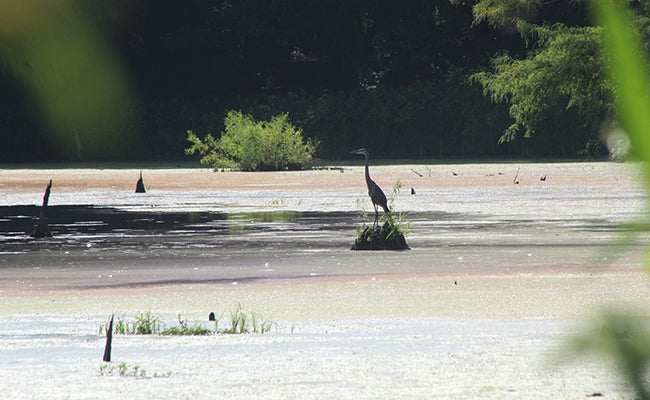Dry conditions are part of ever changing National Wildlife Refuge
Published 2:16 pm Wednesday, August 30, 2023

- A blue heron perches on a rock in the middle of a swamp at St. Catherine’s Creek National Wildlife Refuge. This swamp can be found by taking the Magnolia Trail and is on the southern section of the trail. (Hunter Cloud The Natchez Democrat)
|
Getting your Trinity Audio player ready...
|
SIBLEY — St. Catherine Creek National Wildlife Refuge is facing a dry August for the first time in refuge manager Skye Kreisler’s tenure. Since July 17, there has been no rain until last Thursday and the Mississippi River has dropped to 19.7 feet above gauge zero and continues to fall.
Fall is coming and so is the incoming migration of waterfowl as they make their way down to Mexico. Wading shore birds have already made it to St. Catherine Creek but the Swamp Impoundments are drying up, forcing birds to find water in harder to reach places of the refuge.
The Mississippi River in Natchez is a full foot below where it was last year. Looking back over the last five years, the river levels are trending down. Precipitation records show the rainfall this year is 5.24 inches below the average. Dry conditions are thus causing people to not see wading shorebirds as easily as they have been able to see them in years past.
“The wildlife have faced a number of challenges this year, with the river being low and the rain being scarce. The summer has been excessively dry and hot, and even where we held water for the wading birds (and weed suppression), the pools have all but dried up,” Kreisler said. “This has sent the wading birds (including wood storks, egrets, and roseate spoonbills) further into the northern area of the refuge called the Cloverdale/Cottonmouth unit, which still has water in the swales and basins.”
Kreisler said birders might find their view a little more obscured by plants in the Sibley Unit this year as a result of the drier conditions. She added one of the beautiful things about the refuge is how it is constantly changing and in flux with different species year round.
St. Catherine Creek NWR was established in 1990 to provide an important wintering habitat for migratory birds. The management goal of the refuge is to conserve the dynamic bottomland hardwood forest system in the Lower Mississippi River Valley.
One of Kreisler’s goals in managing the refuge was to encourage the recruitment of new cypress trees especially in the Sibley impoundments known as “The Swamp.” Cypress trees take a while to regenerate so it will take patience to see any changes in the landscape. Kreisler said she plans to plant more cypress trees next year.
“The cypress recruitment at the Swamp consisted of planting forty-two 2 to 5-year old seedlings in the spring, which are surviving the heat under a fresh canopy of pioneering willow trees,” Kreisler said. “Willows grow first in bottomland hardwood forests, helping to hold the soil and provide shade as they grow taller and naturally thin out after a decade or so. The willows are faster-growing than the cypress, so are able to provide much-needed shade to the young cypress, while at the same time challenging them to establish roots to compete for nutrients and water.”






